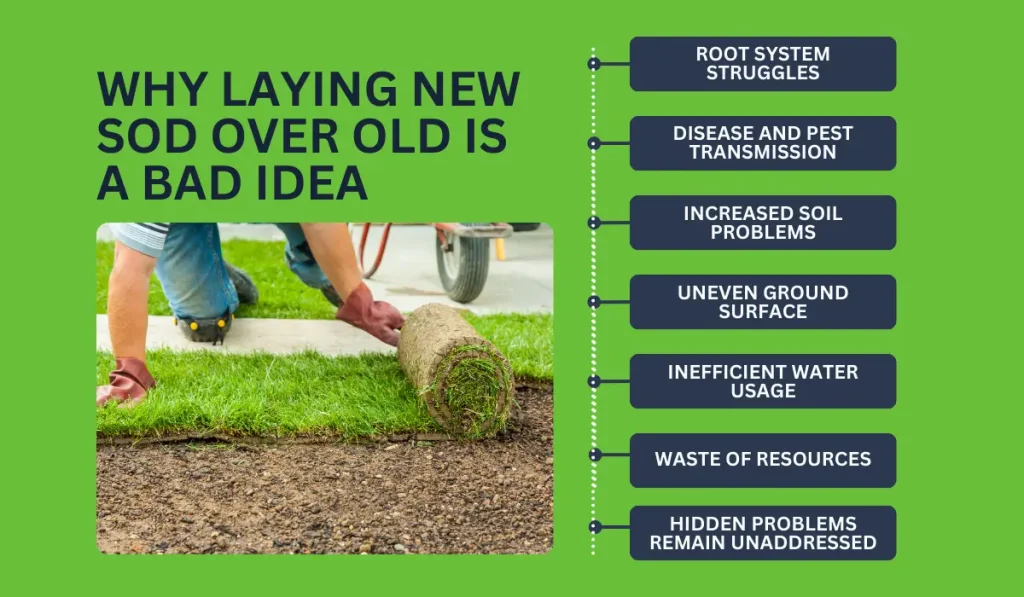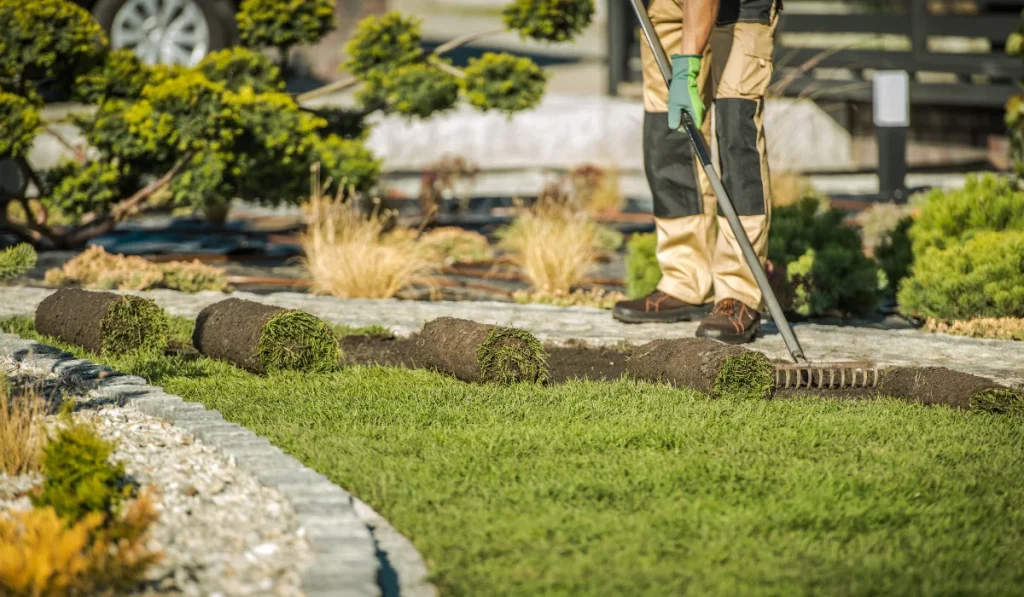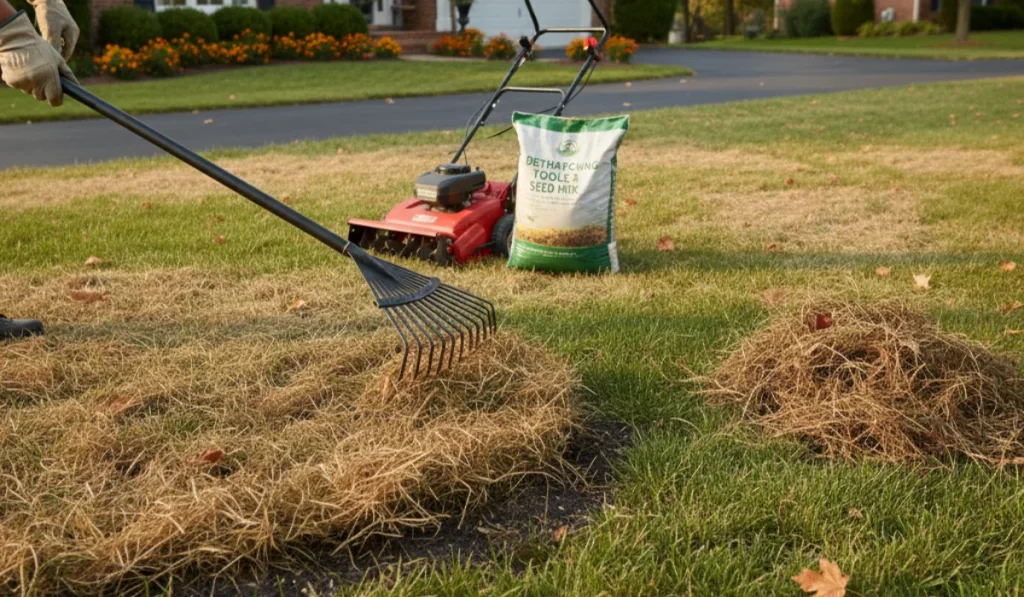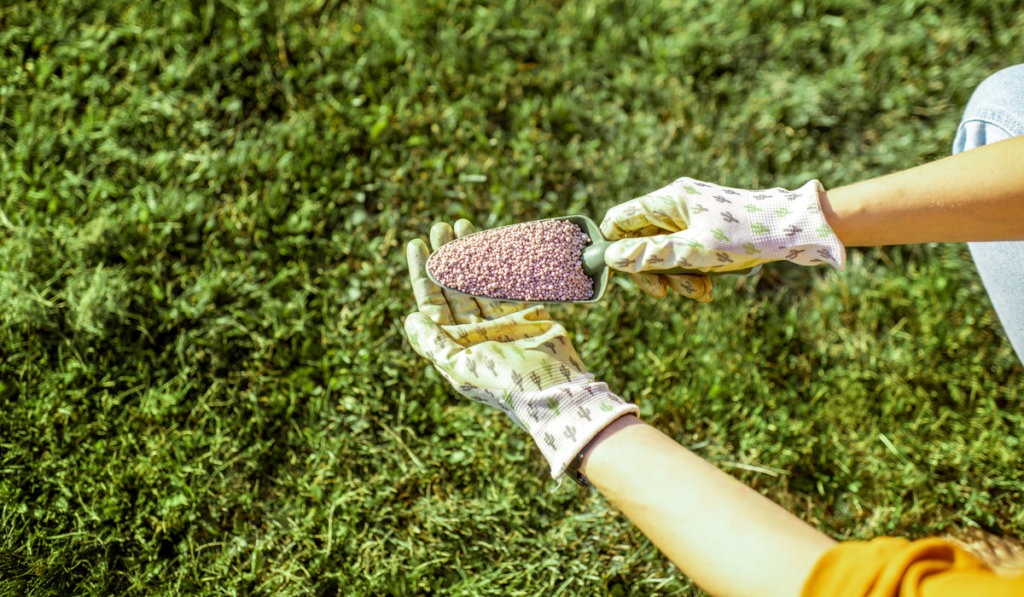Laying sod over an existing lawn might seem like a quick fix for achieving a lush, green yard, but is it really the best option?
While technically possible, laying sod over existing grass is discouraged. New sod needs direct contact with soil for proper rooting, and existing grass creates a barrier.
Will the old Bermuda grass interfere with the new sod’s growth in my driveway? Keep reading to learn the reasons why laying new sod over old is a bad idea.
Key Takeaways
- While technically possible, laying sod over existing grass is not recommended because of its impact on new sod’s health and growth.
- Laying new sod over old grass can inhibit root penetration, reduce nutrient uptake, and exacerbate existing lawn diseases and pest problems.
- Properly replacing old sod involves removing the existing grass, preparing the soil through testing and amendments, and laying new sod for optimal health and aesthetics.
- Critical mistakes to avoid include overlooking pre-existing lawn issues and neglecting aftercare, which is crucial for the new sod’s success.
Is It Possible to Lay Sod Over Existing Grass?
Laying new sod over old sod is generally discouraged because it can lead to several problems that compromise the health and appearance of the lawn.
So, it’s advisable to remove any existing grass and prepare the soil adequately before laying new sod to ensure optimal growth and health of the new lawn.
Why Laying New Sod Over Old Is a Bad Idea

Root System Struggles
Laying new sod on top of an existing lawn can significantly impede the development of a healthy root system.
Here’s a closer look at the specific challenges the roots face in such conditions:
| Root System Challenges | Impact on New Sod |
|---|---|
| Impeded Root Penetration | New sod’s roots struggle to penetrate the old grass layer to reach the soil. |
| Reduced Nutrient Uptake | Limited contact with the soil decreases the new sod’s ability to absorb essential nutrients and water. |
| Stunted Growth | Without deep-root development, the new sod may exhibit poor growth and vitality. |
Disease and Pest Transmission
Old sod might already be harboring diseases or pests, which can compromise the health of the new grass right from the start.
Common risks associated with laying new sod over diseased or pest-infested old grass include:
- Disease Carryover: Diseases such as brown patches or sod webworms may persist and affect the new sod.
- Increased Pest Activity: Pests present in the old sod can quickly infest the new sod, leading to widespread damage.
- Compromised Plant Health: With ongoing pest and disease issues, the new sod is less likely to thrive.
Increased Soil Problems
Covering old sod with new layers can exacerbate existing soil conditions that are unfavorable for grass growth. Here’s how these issues can become more pronounced:
| Soil Issues | Impact on New Sod |
|---|---|
| Compaction | Reduces air and water penetration, crucial for root health. |
| Poor Drainage | Leads to waterlogging, which can suffocate roots. |
| Nutrient Imbalance | Prevents new sod from accessing needed nutrients. |
Uneven Ground Surface
The presence of old sod underneath new sod can lead to uneven surfaces. Here’s how laying new sod over old can affect the ground’s evenness:
- Surface Irregularities: Causes bumps and hollows as the old sod breaks down.
- Aesthetic Disruptions: Results in a lawn that looks uneven and poorly maintained.
- Increased Maintenance: Requires more effort to level and care for over time.
Inefficient Water Usage
Water efficiency is compromised when new sod is laid over old. Specific water-related issues you may encounter include:
| Water Issues | Impact on New Sod |
|---|---|
| Reduced Water Reaching Roots | The old layer traps water, preventing it from reaching the new roots. |
| Increased Water Waste | More water is required to ensure sufficient moisture reaches the soil. |
| Higher Water Costs | Inefficient water usage can lead to increased costs and resource waste. |
Waste of Resources
The practice of laying new sod over old is often a waste of resources due to the reduced chance of successful sod establishment.
Consider these resources that are often wasted in this process:
- Materials Waste: New sod that fails to thrive needs to be replaced sooner.
- Financial Cost: Higher costs incurred from replacing sod and additional treatments.
- Time and Effort: Increased labor and time investment with potentially poor results.
Hidden Problems Remain Unaddressed
Covering old sod with new does not address underlying lawn issues, which are essential for a healthy, green lawn.
Here are the critical problems that may go unnoticed and unresolved:
| Hidden Problems | Impact on New Sod |
|---|---|
| Unseen Pest Infestations | Underlying infestations may continue to damage both old and new sod layers. |
| Ignored Soil Conditions | Necessary soil amendments are overlooked, affecting lawn health. |
| Overlooked Drainage Issues | Water accumulation and related problems may persist, affecting long-term sustainability. |
How to Replace Old Sod With New Grass
While laying sod after removing existing lawns on your own can be successful, professional landscaping services are recommended for hassle-free sod installation and best results.
Removal of Old Sod
Before laying new sod, the first crucial step is the removal of the old or dead grass. As homeowners, here’s how to do it:
- For large areas, using a sod cutter can efficiently remove the top layer of grass and roots or other features like flower beds.
- For smaller areas, a spade or shovel can be used to lift the old sod and herbicides to eliminate weeds.
- Ensure proper disposal or composting of old sod to prevent any regrowth.
- Inspect the exposed layer of topsoil for signs of pests or diseases that may need treatment before laying new sod.
Soil Preparation
Once the old sod is removed, preparing the bare soil is the next step. Here’s how to transition from clearing the old to preparing for the new.
- Testing Soil pH and Nutrients: Conduct a soil test to determine pH levels and nutrient deficiencies.
- Tilling the Soil: With a rototiller, till the soil to a depth of about 6-8 inches to loosen and aerate it.
- Adding Soil Amendments: Based on soil test results, add necessary amendments like organic matter, peat moss, or lime.
- Leveling the Ground: Smooth and level the area to eliminate any low spots and ensure even sod placement.
Laying New Sod
With the old sod removed and the soil properly prepared, the final step is laying the new sod. Here’s how to successfully integrate new sod into your lawn.
- Lay the new type of grass from a reputable sod farm during the cooler parts of the day to reduce stress.
- Place sod pieces tightly together without overlapping or leaving gaps.
- Water the sod thoroughly immediately after laying to encourage root growth.
- Use a lawn roller to remove air pockets and ensure good soil contact.
Common Mistakes to Avoid When Laying Sod
Neglecting the problems of the old lawn can cause complications and may result in the new sod failing to root properly.
First, carefully inspect the lawn for any signs of existing issues, such as:
| Lawn Problems or Issues | Recommended Action |
|---|---|
| Weeds | Remove all weeds to prevent them from competing with the new grass. |
| Pests | Treat any pest infestations to avoid damage to new sod. |
| Soil Compaction | Aeration is required to ensure good soil structure for root growth. |
| Thatch Layer | Remove excess thatch to improve water and nutrient penetration. |
Remember, failing to provide proper aftercare when sprouts start growing from the grass seeds can harm its health. Skipping these steps can lead to poor growth and browning.
Once the high-quality sod is laid, it’s critical to follow a strict lawn care routine as homeowners, such as:
- Keep the soil consistently moist with frequent, shallow watering. Use a sprinkler if necessary.
- Wait two to three weeks before mowing, then gently trim the tops with a sharp mower blade.
- Apply the necessary nutrients with a balanced fertilizer after a few weeks to promote growth.
- Avoid heavy foot traffic on new sod until it has firmly rooted.



